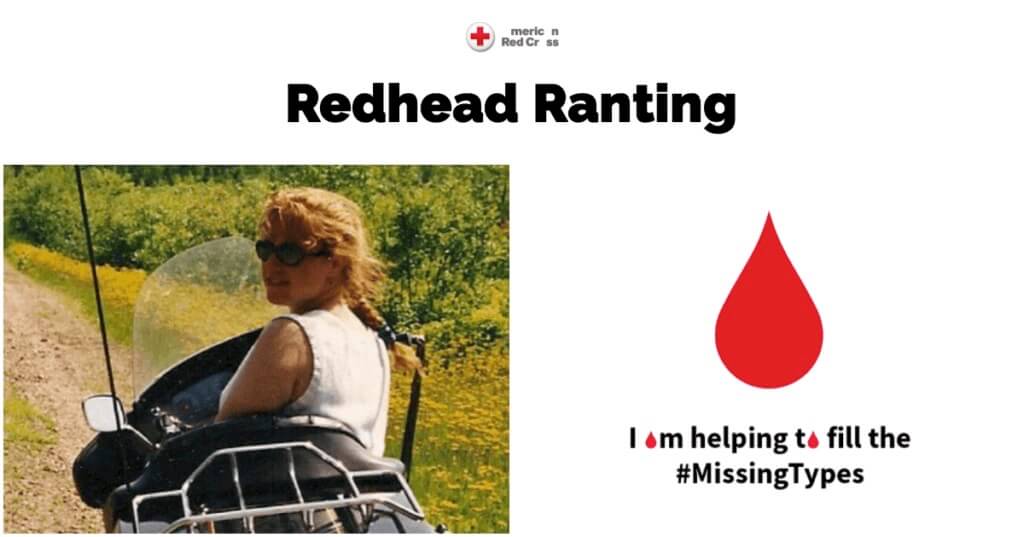New survey finds widespread misconceptions about blood donation
(June 11, 2019) — Today, the American Red Cross launches the Missing Types campaign to raise awareness for lifesaving blood donations and urge the public to make an appointment to give blood or platelets this summer.
During the Missing Types campaign, the letters A, B and O – the letters representing the main blood groups – are disappearing from brands, social media pages, signs and websites to illustrate the critical role blood donors play in helping patients. When the letters A, B and O vanish from everyday life, the gaps are striking. And when A, B, O and AB blood types go missing from hospital shelves, patient care and medical treatments are affected.
Blood transfusion is the fourth most common inpatient hospital procedure in the U.S. Blood can only come from volunteer blood donors, yet only 3 out of 100 people in the U.S. give blood. That’s simply not enough to help patients who need transfusions.
“Just last month, the Red Cross experienced a critical shortage of type O blood. When this happens, medical procedures could be delayed because blood products are not available,” said Cliff Numark, senior vice president, Red Cross Blood Services. “That’s why we are asking those eligible to help fill the missing types by making a donation appointment today. Don’t wait for the letters A, B and O to go missing from hospital shelves again.”
Donors can help fill the missing types by making an appointment to give by visiting RedCrossBlood.org/MissingTypes, using the Red Cross Blood Donor App or calling 1-800-RED CROSS (1-800-733-2767).
Survey reveals public misconceptions about blood needs and donation
A 2019 national survey, conducted on behalf of the Red Cross, revealed a troubling disconnect between the public’s perception of blood donations and the realities of patient transfusion needs.
· A third (33%) of the public has never considered that blood may not be available when a loved one needs it.* Just last month, the Red Cross only had only six units of type O blood available for every 100,000 people, but more than twice that is needed every day.
· Clothes (69%), money (63%) and food (53%) are the primary ways that the public has donated to help others in the past year.* Only 3% of people in the U.S. give blood.
· Blood transfusion is one of the most common hospital procedures in the U.S. Yet, “Never really thought about it” was the primary reason (26%) that people do not give blood among those who haven’t given recently.*
· More than half (54%) the public believes it is necessary to know their blood type in order to donate blood—this is simply not true. Potential blood donors do not need to know their blood type before giving blood. After individuals give blood, the Red Cross provides each donor their blood type.
Missing blood products can lead to delays in treatment
Blaze Eppinger has had the Sickle Cell disease since birth. When he’s not volunteering for the Sickle Cell Foundation of Georgia, he enjoys watching TV shows – like Game of Thrones – and playing videos games. As a child, Eppinger would receive blood transfusions at least once a month. Today at 28, he receives blood transfusions nine to ten times a year, and receives at least three units each visit; which adds up to about 30 units of blood a year. He has Type A+ blood.
“When blood is not available for me, I would have to stay in the hospital longer, basically fighting a sickle cell crisis.” Eppinger explained that a sickle cell crisis is very painful. The pain would start at one part of his body and migrate throughout his entire body. The hospital would give him pain medicine to maintain, but the crisis would only continue until he receives at least 3 pints of blood.
“When I receive the blood donations that I need and my numbers go up, I feel like I’m back to myself,” said Eppinger. “I don’t feel the pain. I don’t feel drained. It’s like putting gas in the car or batteries in your remote. I’m energized!”
Eppinger thanks the Red Cross and it’s volunteer blood donors. “Blood donors may not think about where the blood goes at the time of their donation, but I consider them as silent heroes. It’s just a task to them, an hour of their time, but that task helps save lives. If it wasn’t for generous blood donors, I wouldn’t be alive.”
New donors needed
More donors, and new donors in particular, are needed to maintain a sufficient blood supply for patients like Blaze Eppinger. Donating blood is a simple process and only takes about an hour from start to finish.
· Registration: Sign in, show ID and read required information.
· Health check: Answer questions and receive a mini-physical.
· Donation: Giving a pint of blood only takes about eight to 10 minutes.
· Refreshments: Donors enjoy snacks and relax before resuming their day.
Donation appointments and completion of a RapidPass are encouraged to help speed up the donation process. RapidPass lets donors complete the pre-donation reading and answer the health history questionnaire online, on the day of their donation, by visiting RedCrossBlood.org/RapidPass from the convenience of a mobile device or computer, or through the Blood Donor App.
National brands lending support
The Red Cross appreciates the support of its lead partners who have joined the #MissingTypes campaign, including: Ace Hardware, Adobe, Amazon, AVANGRID, Boise Paper, CarMax, The Clorox Company, The Coca-Cola Company, Domino’s, Facebook, Google, Herbalife Nutrition, IBM®, Land O’Lakes, Inc., Mall of America®, Nationwide®, OnStar, Oreo, PayPal, Salesforce, State Farm®, Suburban Propane, Sunoco, U.S. Bank, Zaxby’s Franchising LLC and Zebra Technologies Corporation. Regional brands in Georgia lending support: AT&T Midtown and Sickle Cell Foundation of Georgia.
How to donate blood
All blood types are needed to ensure a reliable supply for patients. A blood donor card or driver’s license or two other forms of identification are required at check-in. Individuals who are 17 years of age in most states (16 with parental consent where allowed by state law), weigh at least 110 pounds and are in generally good health may be eligible to donate blood. High school students and other donors 18 years of age and younger also have to meet certain height and weight requirements.
About the American Red Cross:
The American Red Cross shelters, feeds and provides emotional support to victims of disasters; supplies about 40% of the nation’s blood; teaches skills that save lives; provides international humanitarian aid; and supports military members and their families. The Red Cross is a not-for-profit organization that depends on volunteers and the generosity of the American public to perform its mission. For more information, please visit redcross.org or cruzrojaamericana.org, or visit us on Twitter at @RedCross.
Supplemental Information about Survey Methodology
*These are the findings from a poll conducted Feb. 22-27, 2019, on behalf of the Red Cross. For the survey, a sample of 1,000 adults ages 18 and over from the continental U.S., Alaska and Hawaii was interviewed online, in English. The precision of Ipsos online polls is measured using a credibility interval. In this case, the poll has a credibility interval of ±3.5 percentage points for all respondents surveyed.










Leave A Comment